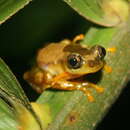Description
provided by AmphibiaWeb articles
A large (Males 28–34 mm, females 32–35 mm) forest Afrixalus from West Africa. Dorsum dark brown with a light pattern normally leaving a brown lumbar band and a rectangular brown dorsal spot, the anterior part of which normally extends a little up onto the upper eyelid. Tibia with two light spots.Although the pattern can vary, A. nigeriensis is easy to distinguish from the only other brown and silverish Afrixalus occurring together with it, namely A. dorsalis. A. nigeriensis is larger, with broader head, more protruding eyes and with discs and fingers bright orange in life. Some of the known samples of this species, namely those from Côte d’Ivoire and Ghana, show considerable variation in pattern. The silverish pattern that seems to overlay the dark brown ground colour can vary both in extent, being more or less reduced, and in ”density” in the way that the dark ground colour sometimes peeps through the silverish cover as diffuse spots. Since this great variation in pattern has been found in samples from single localities, it apparently does not have systematic significance.When described in 1963 this frog seemed to belong with a group of forms regarded as subspecies of the central African A. congicus (now termed A. osorioi), as did the Cameronese A. paradorsalis, but for morphological and zoogeographical reasons it is best regarded as a full species. The voice is typical of the larger Afrixalus: a slow, creaking initial sound is followed by a succession of rather unmeloduous clicks with an indistinct frequency-intensity maximum of about 3000–3300 cps. and a rate of about 8–9 per second.This account was taken from "Treefrogs of Africa" by Arne Schiøtz with kind permission from Edition Chimaira (http://www.chimaira.de/) publishers, Frankfurt am Main.
Distribution and Habitat
provided by AmphibiaWeb articles
Afrixalus nigeriensis is strictly a forest form. In West Africa it is generally found in the same areas as Afrixalus dorsalis but the two species show a clear ecological separation, even in the few cases where both species were found at the same breeding site: A. dorsalis then calls from the open, exposed part of the site, e. g. close to a road while nigeriensis calls from denser vegetation, bordering up to forest. Widely distributed in suitable habitats throughout West Africa from River Niger westwards to Liberia. It may occur in the little-explored remnants of forest – if any are left – between Niger and Cross River, and may very well occur in Liberia. It was not found in suitable habitats in eastern Sierra Leone, where A. dorsalis seems to have taken its place.
Life History, Abundance, Activity, and Special Behaviors
provided by AmphibiaWeb articles
The eggs are placed on a leaf above water which is then folded and glued together. The tadpoles are streamlined with a tooth formula of 0/1. One tadpole had a length of 26 mm (8 + 17) and a maximum tail height of 5 mm.
Nigeria banana frog: Brief Summary
provided by wikipedia EN
The Nigeria banana frog (Afrixalus nigeriensis) is a species of frog in the family Hyperoliidae. It is found in southeastern Guinea, Liberia, Ivory Coast, Ghana, and western Nigeria; it appears to be missing from Togo and Benin. Its natural habitat is primary rainforests, but it can also be found in a farm bush. The eggs are laid on vegetation, overhanging temporary ponds. It is threatened by habitat loss caused by agricultural encroachment, expanding human settlements, and logging. A high prevalence of Batrachochytrium dendrobatidis, the fungus causing chytridiomycosis, that has been associated with amphibian declines elsewhere, has been demonstrated in specimens collected from the Okomu National Park in Nigeria.
- license
- cc-by-sa-3.0
- copyright
- Wikipedia authors and editors

